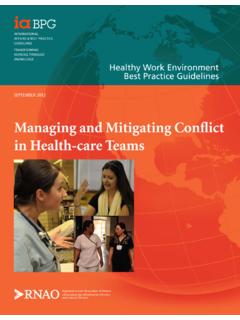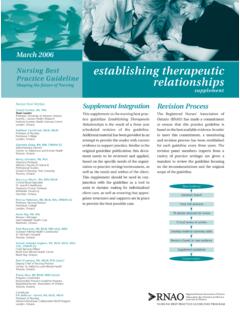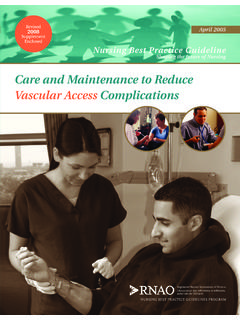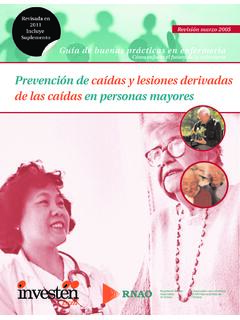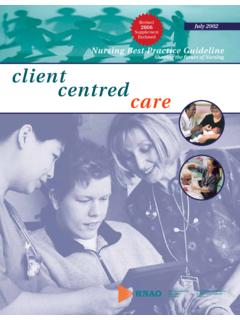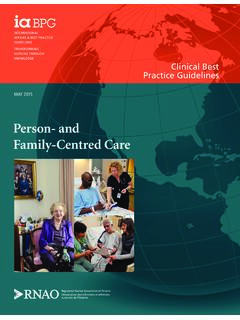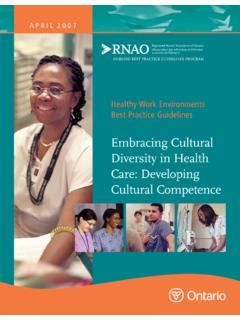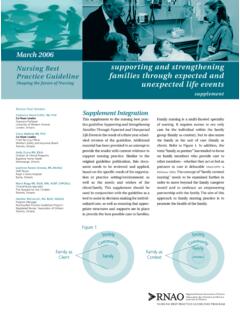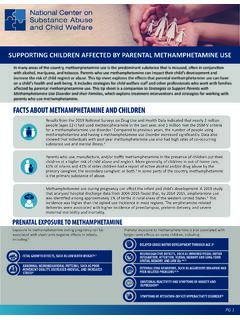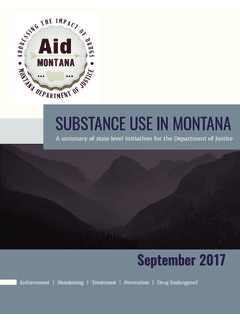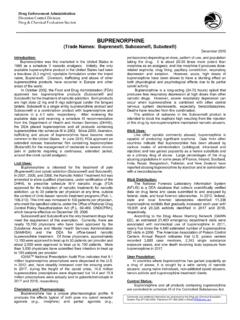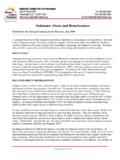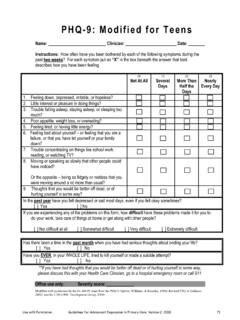Transcription of SYNOPSIS OF FIRST NATIONS SUBSTANCE ABUSE ISSUES ... …
1 SYNOPSIS OF FIRST NATIONS SUBSTANCE ABUSE ISSUES Developed for use by the RNAO Authors Linda Sullivan, Renewal Project Coordinator, and National Native Addictions Partnership Foundation 1 | P a g e SYNOPSIS The legacy of colonization and oppression, loss of culture and language and the resulting intergenerational trauma experienced by many FIRST NATIONS people and communities since contact has significantly impacted health and wellbeing, especially in the context of SUBSTANCE ABUSE and related mental health ISSUES . Referred to as the Indigenous social determinants of health , influence beyond physical health , connection to indigenous culture and language, income, education, employment, housing, social support, access to health services, etc.
2 , intertwine with and directly affect health. The Indigenous social determinants of health are the root causes of poor health. It is essential for providers to understand the impact and relationship between these determinants of health and the need to develop and practice a more holistic view of health. In addition to these social and economic factors, FIRST NATIONS health and wellness is also affected by historical and culturally-specific factors that include the loss of language and connectedness to the land, residential school abuses, systemic racism, environmental destruction and cultural, spiritual, emotional, and mental disconnectedness. The myriad of social, historical and cultural factors that have dramatically impacted FIRST Nation people has, as such, placed the issue of SUBSTANCE ABUSE and related mental health ISSUES atop the priorities for FIRST NATIONS individuals, communities and leaders.
3 This was demonstrated in the FIRST NATIONS Information Governance Centres , national longitudinal health survey of FIRST Nation communities conducted from 2008 to 2010 wherein of respondents communities said that the misuse of alcohol and drugs on-reserve was identified as their primary concern for community wellness. As demonstrated in the Honouring Our Strengths framework model (Figure 1), the foundational component required to achieve health and wellness for FIRST Nation individuals, families and communities is to ensure that the system of care is holistic, strength-based and, most importantly, founded on cultural. Central to this system of care is the necessity for all care and service providers to FIRST Nation people both on and off-reserve, to employ and practice in a culturally competent and culturally safe way in order to support the diverse needs of FIRST NATIONS people.
4 The goal of achieving wellness is essential. Wellness is distinct from the western medicalized model of health wherein wellness is based on a holistic approach to wellbeing that promotes balance of mental, physical, emotional and spiritual. Wellbeing and wellness requires the invocation of culture as the central component. Culturally specific interventions address the needs and interconnectedness of the mind, body, spirit and emotions simultaneously. How culture is attended to in addressing SUBSTANCE ABUSE , including prescription drug concerns, must be guided by the following concepts: Culturally Competent: Cultural competence requires that service providers, both on- and off reserve, are aware of their own worldviews and attitudes towards cultural differences; and include both knowledge of, and openness to, the cultural realities and environments of the clients they serve.
5 It is also necessary for indigenous knowledge to be translated into current realities to meaningfully inform and guide direction and delivery of health services and supports on an ongoing basis. Culturally Safe: Cultural safety extends beyond cultural awareness and sensitivity within services and includes attention to cultural, historical and structural differences and power relationships within care and access to services. It involves a process of ongoing self-reflection and organizational growth for service providers and the system as a whole to respond effectively to FIRST NATIONS people (Health Canada, 2011). 2 | P a g e Cultural relevancy requires acting in a culturally competent manner to ensure that any action based on culture respects the diversity of culture and is specific to the individual, family or community.
6 There can be challenges for healthcare professionals working with unregulated professions, such as cultural practitioners and Elders. Other divisions can be raised by differing world views, lack of appreciation or understanding for indigenous knowledge and western knowledge, and jurisdictional differences specific to governance, funding and policy. These challenges and barriers must be worked through with mutually agreeable roles, responsibilities, goals and expected outcomes. Figure 1: 3 | P a g e FIRST NATIONS reports indicate higher rates of emotional and physical ABUSE of family members, especially of children and elders. Communities with higher than average percentages of drug addiction and chemical dependency have higher incidences of suicide, violent crimes, illegal activity and other forms of ABUSE (AFN, 2011).
7 Other FIRST NATIONS communities have reported epidemics of from 43% (Chiefs of Ontario, 2010) to as high as 85% (Health Canada, 2011) of the communities population addicted to opiates. In these instances there are also external problems, involving child and family services, conflicts with law enforcement, and absenteeism from places of work, education and volunteerism (Chiefs of Ontario, 2010). The 2008 2010 FIRST NATIONS Regional Health Survey revealed that among FIRST NATIONS people aged 18 and older living on-reserve or in northern FIRST NATIONS communities, reported past-year use of illegal (heroin) or prescription opioids (including morphine, methadone and codeine) without a prescription, and reported non-prescribed use of sedatives or sleeping pills, including diazepam and oxaxepam (FNIGC, 2012).
8 Among FIRST NATIONS youth aged 12 to 17, reported using illegal or prescription opioids without a prescription during the previous 12 months and reported non-prescribed use of sedatives or sleeping pills (FNIGC, 2012). Honouring Our Strengths and the Mental Health Commission of Canada s Changing Directions, Changing Lives: The Mental Health Strategy for Canada both identify that in order to address the complex SUBSTANCE ABUSE and mental health ISSUES faced by northern and remote FIRST Nation communities, new collaborative partnerships between governments and organizations are needed to effectively implement successful holistic service delivery models. It s critical that FIRST Nation communities have access to funding and support to develop, implement, and evaluate their own solutions to addressing the mental health needs of their own communities1.
9 1 MHCC, 2012. Pg. 86. 4 | P a g e References 1. Assembly of FIRST NATIONS . (2010). Resolution no. 60/2010: Ratification of renewed program framework for the National Native Alcohol and Drug ABUSE Program (NNADAP) and Youth Solvent Addiction Program (YSAP). Retrieved from 2. Assembly of FIRST NATIONS . (2011). Resolution no. 57/2011: Support for Akwesasne leadership in addressing state of crisis regarding SUBSTANCE ABUSE . Retrieved from 3. Chansonneuve, D. (2005). Reclaiming connections: Understanding residential school trauma among Aboriginal people. Aboriginal Healing Foundation. Retrieved from 4. Chiefs of Ontario. (2010). Prescription drug ABUSE strategy: Take a stand.
10 Retrieved from: Final%20 Draft%20 Prescription%20 Drug% 20 ABUSE % 5. FIRST NATIONS Information Governance Centre. (2010). Quick facts: Regional Health Survey 2002/2003. Retrieved from 6. FIRST NATIONS Information Governance Centre. (2012). FIRST NATIONS Regional Health Survey 2008/10: National report on adults, youth and children living in FIRST NATIONS communities. 7. Health Canada. (2011). Honouring Our Strengths: A Renewed Framework to Address SUBSTANCE Use ISSUES among FIRST NATIONS People in Canada 8. Indigenous Physicians Association of Canada and the Royal College of Physicians and Surgeons of Canada, Family Medicine Curriculum Development Working Group. (2009). Cultural safety in practice: A curriculum for family medicine residents and physicians.
